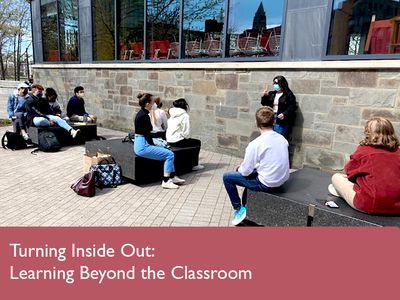Turning Inside Out: Learning Beyond the Classroom

Contributed by CTL staff, with thanks to CAS Writing Program Instructors
(3 minute read)
Summer courses are known for their long and concentrated classes, which can be draining on both the instructor and the students. However, summer classes also offer great possibilities to experiment with content and format. Taking your class outdoors – on BU’s campus and beyond – is one experiment that enlivens the routine of class and offers different opportunities for students to connect with each other, with their instructors, and with their physical surroundings. Instructors from CAS’s Writing Program offer the following suggestions for spaces and activities.
Whether you are finishing Summer I or about to start Summer II, consider the option of taking a class outside to complete activities in the outdoors. There are numerous spaces around the Charles River campus that quickly adapt to outdoor classrooms: in front of the Communication Building on Comm Ave (grassy space as well as a number of chairs); next door to The Towers on Bay State Rd (beautiful, shady space with Adirondack chairs); and in front of Kilachand Honors College, also on Bay State Rd, where a few benches and grassy areas allow students to break into groups for discussion or shared projects. Look for other buildings along Bay State Rd with benches in front of them: in the spring, you may have spotted Marisa Milanese’s documentary film class in front of the English Department building, finishing up class by playing Charades with film titles.
The BU Beach is also a great outdoor space, utilized by instructors to create community with and among students. Swati Rani’s classroom space, profiled in BU Today, was made comfortable with blankets on the grass and deck chairs. The classroom without walls allowed for whole class discussion and group activities (for example, preparing and delivering skits on the class themes).
BU Beach is also a gateway to footbridges over Storrow Drive and onto the riverside walkway. Jessica Bozek uses these spaces for students to “walk and work” in small groups – discussing their interpretations of readings as well as feedback on class assignments. Students have the opportunity to connect with each other, in rotating groups, and with their instructor, as she moves from group to group to have conversation with them about their work.
As events open up to in-person attendance, instructors may also be able to take advantage of happenings on nearby campuses. Jeffrey Gruenglas, for example, likes to extend his medical ethics class through trips to speaker panels at the Mass. College of Pharmacy or biomedical ethics lectures at Harvard Medical School. Students who are not able to attend the excursion have options for make-up work that connect to the topic. Public parks and other spaces close to campus also offer educational opportunities: statues along the Commonwealth Avenue Mall and around the city (for example, the recently restored monument to the 54th Regiment on Boston Common, or the Boston Garden’s “Good Samaritan” monument that pays tribute to the discovery of ether) prompt discussion on public memory and its connection to issues as diverse as race, social justice, medical innovation, gender representation, and voting rights.
More information on the pedagogy of place-based learning can be found on the Writing Program’s Teaching Writing site: the section on Experiential Learning and the Writing Classroom offers teaching strategies and ideas that apply far beyond writing classes, as Holly Schaaf and Allison Blyler explain in their suggestions for activities and resources. Expanding your classroom into outside space extends learning while creating important community connections – make a space for it in your summer class if you can!